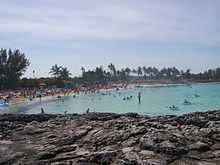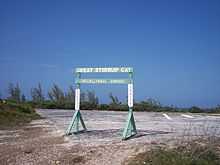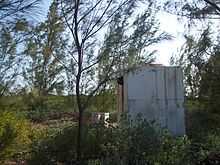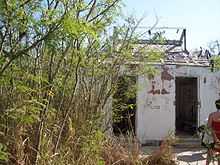Great Stirrup Cay
Coordinates: 25°50′N 077°54′W / 25.833°N 77.900°W








Great Stirrup Cay is a small island that is part of the Berry Islands in the Bahamas. Norwegian Cruise Line purchased the island from Belcher Oil Company in 1977 and developed it into a private island for their cruise ship passengers.
The northern part of the island has a sandy beach surrounded by rocks with snorkeling areas. The southern part features a helicopter airfield (with a sign reading "Great Stirrup Cay International Airport"), a large area without vegetation, and numerous concrete blocks. These are all remnants of a previous U.S. military installation and satellite tracking station. The island's lighthouse was originally constructed in 1863 by the Imperial Lighthouse Service.[1][2]
Great Stirrup Cay is adjacent to Little Stirrup Cay, Royal Caribbean Cruises' private island.
History
Great Stirrup Cay, along with the rest of the Bahamas, was formed by tectonic and glacial shifting. The first known settlers to the Bahamas were the Lucayan Indians, relatives of the Arawaks who populated the Caribbean around 600 A.D.
Great Stirrup was a pirate hideout while the British settled in Nassau and the larger islands until 1815. This time marks the first documented settlers of Great Stirrup, and many of the structures from this settlement still stand today. Charts of this era show simply "Stirrup's Cay".
"Stirrup's Cay" remained active during the American civil war, as the Confederates wished to continue to export cotton to Europe. The island was used as a landfall for provisioning while Federal warships patrolled the area to thwart their efforts.
After the abolition of slavery, the British began to slowly withdraw from the out island colonies, and the plantation at Great Stirrup was abandoned.
Great Stirrup is the northern most island in a chain of islands known as the Berry Islands, and is situated in an area along the Northwest Providence Channel. In 1863, the Imperial Lighthouse Service erected the lighthouse on Great Stirrup Cay. The lighthouse site was manned for many years, but it is now timed and solar powered, making it self-sufficient. The structure stands nearly 80 feet, and its light is visible for over 20 miles.
During World War II the United States, in an effort to protect its eastern shores, came to the Bahamas and Great Stirrup with a wide array of observational and defensive equipment. Among these were submersible cables, which were run along the ocean floor to listen for enemy submarines. Two "cable houses" still stand on the southeastern shore of the island, also overgrown by jungle.
The United States Air Force later constructed a satellite tracking station. This facility was later leased to Motorola, and other private sector companies. New technology has made the station obsolete, and it was closed in 1991.
Belcher Oil Company of Miami staked claim to the north section of the island for many years. Their interests there included real estate speculation, oil exploration, and a possible site for a corporate retreat. In 1977, Norwegian Caribbean Lines (later Norwegian Cruise Line) acquired this section from Belcher Oil.
Flora and fauna
The most common tree on the island is the coconut palm, which produces a cloudy milk and a sweet meat used in many island recipes. Another fruit-bearing tree is the Sea Grape.
Wildlife
Some of the creatures found on the island include several different varieties of lizard and land crab. Gulls, frigates, and sanderlings are the most prevalent bird species.
Great Stirrup Cay is a protected marine life sanctuary, and removal of anything from the water is strictly prohibited.

References
| Wikimedia Commons has media related to Great Stirrup Cay. |